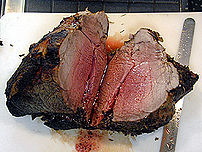Those plump breasts often come ‘enhanced’ with saltwater broth.
Most people don’t think of uncooked chicken as a significant source of sodium — but it can be, not just because most cooks use salt as seasoning.
Injecting raw chicken with saltwater solutions during processing is a widespread practice in the poultry industry. It’s also a practice that has the industry increasingly divided. Major producers who inject their products with saltwater solutions say it makes for tastier, juicier meat. Other producers promote their products as free of the additive and say that the practice is deceptive.
Granted, poultry producers on both sides of the issue are probably vying for a market edge. But marketing wars aside, the practice of saltwater plumping has ruffled the feathers of many nutrition experts too. “People believe that when they’re getting chicken, they’re getting a low-sodium food,” says Liz Trondsen, a registered dietitian at Hollywood Presbyterian Medical Center in Los Angeles and a spokeswoman for the American Heart Assn.”They need to be aware of this.”
Raw chicken breast can contain as little as 50 to 75 milligrams of sodium per 4-ounce serving. But much of the chicken on the market in the U.S. is “enhanced” — injected with a salt solution, or broth, during processing. Sodium levels often reach well over 400 milligrams per serving — nearly one-third of the maximum daily intake of 1500 milligrams recommended for people at risk of high blood pressure (including African Americans and older adults). High sodium levels can cause and aggravate high blood pressure, which increases the risk of heart disease and stroke.
Producers have been injecting chicken (and other meats) with saltwater solutions since the 1970s, says John Marcy, professor and poultry processing specialist at the University of Arkansas at Fayetteville. The practice makes for more flavorful meat, he says, because “a consumer can’t put salt into chicken like a processor can.”
Processors use multiple-needle injectors or vacuum-tumblers, which force the sodium solution into the muscle. Binding agents in the solution prevent the added salt and water from leaching out of the meat during transport, in grocery stores and during cooking, says Kenneth McMillin, professor of meat science at the Louisiana State University Agricultural Center in Baton Rouge.
The labels on saltwater-infused meats typically say “enhanced with up to 15% chicken broth.” They can also say “all natural” if ingredients in the solution meet the U.S. Department of Agriculture definition of natural, says Bryn M. Burkard, a public affairs specialist with the agency’s Food Safety and Inspection Service.
The Truthful Labeling Coalition, a Washington, D.C.-based coalition of poultry producers that don’t enhance their products, is pressing the USDA to change that policy. “The labels [on raw poultry] are really misleading,” says Charles Hansen, executive director of the coalition. “We’ve got no objections to them adding saltwater to chicken, but why not list it prominently on the label?”
The USDA is reviewing comments on the policy, Burkard says. But though clearer labeling may help consumers avoid excess sodium in the chicken they buy at grocery stores, they’ll still encounter high sodium levels in chicken dishes in restaurants and cafeterias. “In the food services industry, chicken has always been injected to retain moisture,” Marcy says. “It’s been standard practice for decades.”
And despite the high levels of sodium in enhanced chicken, it’s still not the top source of hidden dietary sodium, Trondsen says. Consumers should generally be more concerned with the typically high levels of sodium in frozen and canned foods, processed foods, soups and condiments, she says. An 8-ounce serving of canned soup can often contain 700 to 900 milligrams of sodium, and many frozen dinners contain well over 1,000 per meal.
Nonetheless, at more than 400 milligrams per serving, the sodium levels in plumped chicken are significant. “Pity the poor person trying to cut down on salt,” says Marion Nestle, professor of nutrition, food studies and public health at New York University, and the author of the 2006 book “What to Eat.” “It gets put into everything and you don’t have any choice about it.”
Nestle adds that not only does the practice of saltwater plumping add unnecessary salt to people’s diets, it also increases the water weight of chicken. Livingston, Calif.-based Foster Farms, a member of the Truthful Labeling Coalition, has estimated that consumers are paying an average of $1.50 for added saltwater per package when they purchase enhanced chicken.
“This practice manages to do not one but two bad things,” Nestle says. “It increases the water weight of the chicken so you are paying for water, not chicken, and it adds salt that you don’t need.”
Source: Los Angeles Times
![Reblog this post [with Zemanta]](https://i0.wp.com/img.zemanta.com/reblog_e.png?w=580)











